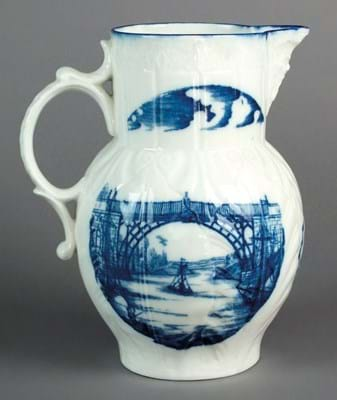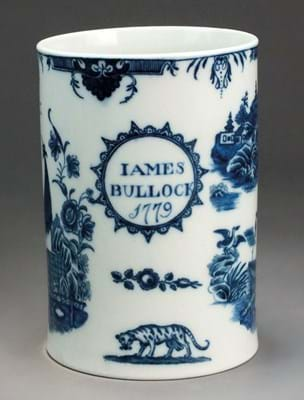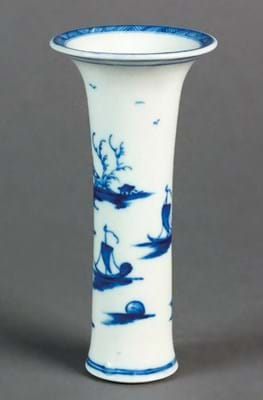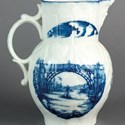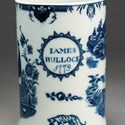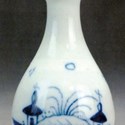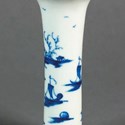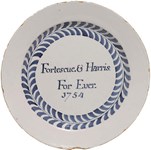Single-owner, single-factory ceramics collections are always useful when they come up for auction. They give a snapshot of a market at a particular time.
Some factories are more widely collected than others. Chelsea, with its sophisticated early wares made for wealthy patrons, attracts international interest; Worcester, with its long production run and variety of styles, has many adherents.
Others occupy more niche sectors. One such is Caughley, the soft paste porcelain produced in Shropshire from the early 1770s until 1799 when the factory was bought by John Rose founder of Coalport.
During its run of just under two decades, Caughley produced largely useful wares in underglaze blue with either printed or painted patterns.
Occasionally these were distinguished by dates and inscriptions or, more rarely, by local scenes, and they also made miniature or toy wares. All of these are desirable features that can push up prices, but Caughley has never reached the kind of levels achieved by Chelsea, early Worcester or even fellow niche factory Lowestoft.
Caughley undoubtedly has its fans, however, aided perhaps by its affordability. There is a collecting society and a certain amount of literature (although there is no monograph) and a study collection at the Ironbridge Gorge Museum. One of these enthusiasts is Maurice Wright, chairman of the Caughley Society. He and his wife Janet started buying Caughley in the 1970s, focusing on a factory relatively near to their West Midlands home.
This eventually crystallised into the aim of assembling as comprehensive a range of patterns as possible and a pattern listing that formed the basis for a book published in 2012 by the Caughley Society.
Having spent nigh on half a century amassing what he describes as a collection that grew like topsy “until it was overgrown”, Wright decided to sell. The entire assemblage came up for auction as part of Halls’ Country House sale on April 27.
“Having spent nigh on half a century amassing what he describes as a collection that grew like topsy ‘until it was overgrown’, he decided to sell
Shropshire-based Halls (20% buyer’s premium) was a good choice. It has established something of a track record with sales from its local porcelain factory, having dispersed the Bawden and Kitson collections in recent years.
Caroline Dennard, Halls’ specialist who has sold all three collections, says: “We have opened it up a bit, we are getting new collectors coming in now, not just the standard Caughley Society members.
“A lot of people are coming out of the woodwork whom we have not seen before and saying that they collect Caughley.”
Wright’s odyssey took him up and down the country in pursuit of his goal. He purchased widely from auctions and well-known dealers, some now departed, such as Sheila Davis and Liane Richards, and some still very much in the running like Simon Spero, Roderick Jellicoe and Jupiter Antiques.
Wright reckons that while his collection may not be the best or biggest in private hands, “nevertheless it is probably the most representative to come onto the market with some undoubted rarities…”. It added up to more than 400 pieces covering all levels of quality, rarity and value.
Dennard had put together a good scholarly catalogue referencing the Caughley pattern book and provenances. It was, says Dennard, “the first time they have been isolated in such detail and put on the market with that information”, making the catalogue a useful record in years to come.
Eagerly awaited sale
Not surprisingly this one-stop shop was an event eagerly awaited by members of the Caughley Society and other collectors.
But these things cut two ways. As a big collection with plenty of choice, buyers did not need to fight over everything and, of course, if money is limited, purchasers have to be more selective.
Moreover, when a big collector such as Wright turns vendor it not only brings a lot to the market, it also takes a major purchaser out of the running.
As Dennard observed, there have been several Caughley dispersals recently, not only Halls’ two earlier sales but also the major collection of Roger Edmundson sold by Mellors & Kirk in June 2015.
But there was a good turnout for the event. Halls held a private viewing for the Caughley Society before the auction and, as Dennard notes: “There are something like 93 Caughley households in Britain; around 80 came to the evening view and most of them came to the sale. It was a full room, with no spare seats.”
Estimates for the sale were largely reasonable but not giveaway. Buying from the room and online via thesaleroom.com meant around two-thirds of the 324 lots got away.
The sale got off to a good start with a selection of miniature pieces. These have crossover appeal beyond the factory and prices were bullish for a number of examples such as the £1150 Island guglet or the £1700 Three Boats vase.
The highest price was paid for what was arguably the star of the collection: a 7in (18cm) high mask face jug.
“We have opened it up a bit. We are getting new collectors coming in now, not just the standard Caughley Society members
It was a desirable Caughley shape, was dated (1790), initialled JH or possibly IH and was painted with a local scene – a Severn trow passing under the Shropshire Iron Bridge.
Wright had bought this in the same rooms in 1986 when it was Hall Waterbridge and Owen, having sold “over 20 good pieces I would rather have kept” in order to fund the purchase. Last month it went to a bidder in the room for £3700, a mid-estimate sum that Dennard, described as “a steal compared with London prices”.
There was more of a battle for an earlier 5½in (14cm) high mug that Wright had purchased in 1993 from Venners Antiques. This too was inscribed and dated (James Bullock, 1779) but had an extra attraction in the combination of its transfer printed patterns.
These were a version of the Fisherman pattern that was the first known dated piece, plus a variant border and a rare Tiger pattern. Bidding on this went to £2300 against a £1000-1500 guide.
Another very early 4in (11cm) high mug inscribed and dated M over RE and 1776 just topped upper estimate at £3100.
Pounce pot
A pounce pot printed with sprigs purchased at a house sale in 1980 was guided at £2500-3000 but got away for just £1800. Another with the same estimate met with less success. Part of a small group of Caughley from other sources, it had been sold three years ago at Halls for £3100 but failed to find a buyer here.
The vast majority of the Wright lots were more modest versions of the factory’s output pitched at the three-figure levels and it was these pickle leaves, sauceboats, plates, dishes and cups that made up the lion’s share of the £72,000 total realised by the collection.


